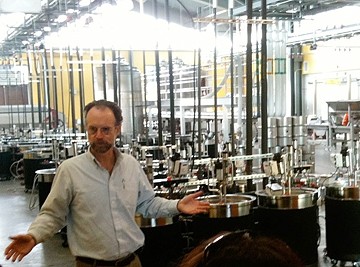New winery and brewery aims to be carbon neutral
The construction of the site was completed in July and is expected to be the first winery and brewery facility to earn LEED Platinum certification, the highest environmental rating awarded by the US Green Building council.
A model for industries
The university claims that its 34,000-square-foot centre will operate as “the most environmentally sophisticated complex of its kind in the world”. The complex is designed to serve as a test-bed for production processes and conservation techniques for both students and commercial suppliers.
The centre aims to become carbon neutral from emission and energy generation within two years. The second phase under consideration will make the winery "self sustainable" in water and energy. The university is currently raising funds for facilities that will be able to re-use 90 per cent of captured rainwater volume.
Roger Boulton, a Professor of Enology and Chemical Engineering at the University told BeverageDaily.com that the centre is an example for the global community and not just for California or wine companies. “The technologies and environmental demonstrations have applications in all food and fermentation industries,” hesaid.
Wine fermentation system.
UC Davis claims that its winery will hold not only the world’s first wireless wine-fermentation system but also has said that it is also expected to be one of the world’s largest wireless networks in terms of fermentation facilities.
A $1m assembly of 152 wireless grape fermentors will be used to remove the carbon dioxide released from the winery, reducing the building’s energy requirements for air quality and temperature control.
“We will use existing (actually very old chemistry) to sequester CO2 onsite. We expect to do this within two years in the next phase of the project,” said Boulton.
The professor said that it was likely that commercial companies would start using such systems in the future and that he thought that they would probably purchase such systems from companies that offer them in the future as most wineries are too small to develop and trouble shoot such systems themselves. But he said that “Time will tell” whether wineries would make the switch.
“We will be generating the necessary data for people to make those decisions. A major problem at present is that the operating data is not available for companies to even analyse these options accurately,” he added.
The south wing of the new one-story complex is home to the Brewing and Food Science Laboratory and includes a brewery, a general foods-processing plant and milk-processing laboratory. The facilities will be used to facilitate and support research on a range of different topics.
The new brewery will provide commercial brewers and suppliers with a small-scale facility to test recipes and processes. “In the brewery we are seeking to engage brewers and suppliers globally. This will be on a charged basis,” Charles Bamforth, the Anheuser-Busch Endowed Professor of Malting and Brewing Sciences in the Department of Food Science and Technology told BeverageDaily.com.
Bamforth also said that the brewery will continue to invest in equipment “for the training of tomorrow's brewers and the pursuit of research excellence”.
Other environmental features of the complex include rooftop photovoltaic cells and food-processing equipment that minimises energy and water requirements.
The institute opened in 2008 and comprises three academic buildings that house the Department of Food Science and Technology and the Department of Viticulture and Enology.
Funded entirely by private donations, the new complex was designed and built to be UC Davis’ second LEED Platinum building and only the third in the UC system.






